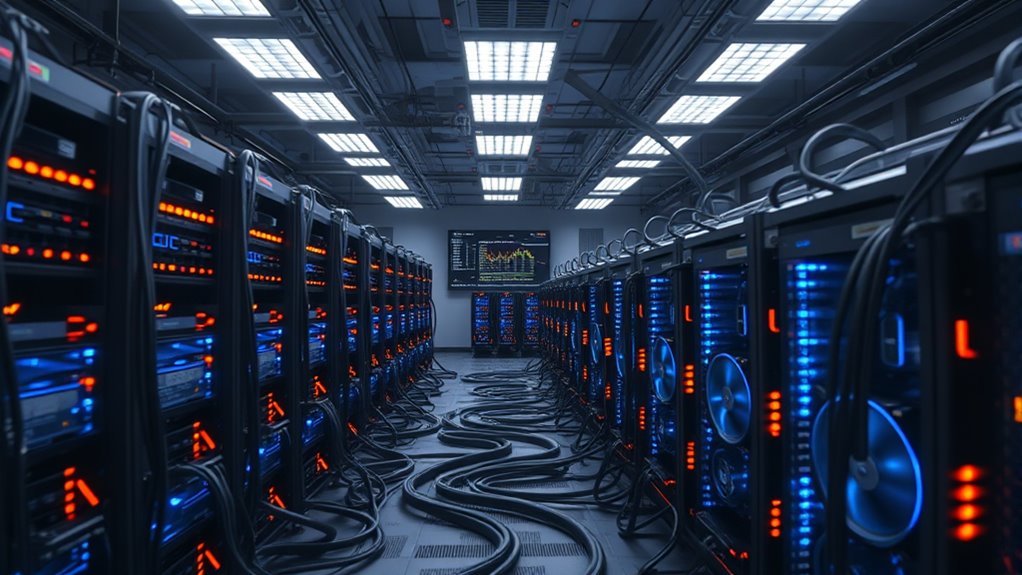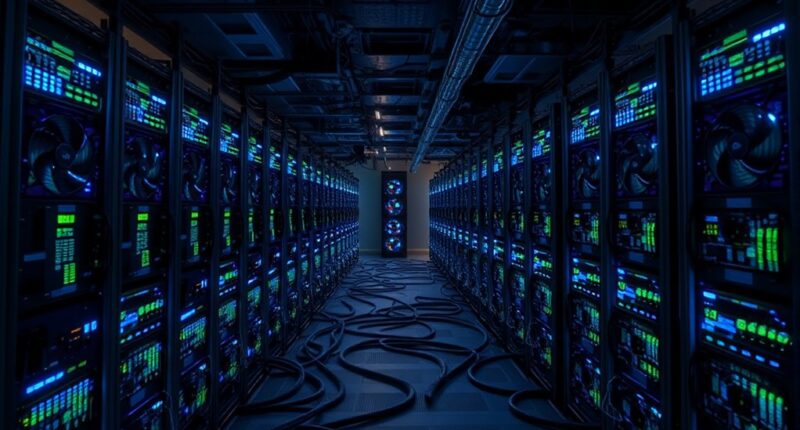Crypto mining in a proof-of-work blockchain involves using powerful computers to solve complex puzzles that validate transactions and add new blocks to the chain. You set up mining hardware, like GPUs or specialized ASICs, to compete in this process. As your hardware solves these puzzles, it secures the network and earns rewards. Understanding how hardware impacts speed, energy, and decentralization reveals the core of mining operations—and there’s more to explore if you keep going.
Key Takeaways
- Proof-of-Work (PoW) requires miners to solve complex mathematical puzzles to validate transactions and add new blocks.
- Miners use specialized hardware like ASICs or GPUs to perform these computations efficiently.
- The first miner to solve the puzzle broadcasts the new block, earning cryptocurrency rewards.
- PoW secures the network by making malicious attacks costly and computationally impractical.
- Hardware performance and energy consumption significantly influence mining speed and network scalability.

Have you ever wondered how cryptocurrencies like Bitcoin are created? It all comes down to a process called mining, which relies on the power of computers to validate transactions and secure the blockchain. When you think about blockchain scalability, it’s essential to understand that the more people use a blockchain, the more data it has to handle. If the network gets overwhelmed, transaction times slow down, and costs can spike. That’s where mining hardware plays a pivotal role. The better your hardware, the more efficiently you can solve the complex puzzles needed to add new blocks to the chain, keeping the network running smoothly.
Mining hardware has evolved markedly over the years. Early on, miners used standard CPUs, but as the difficulty of mining increased, they transitioned to GPUs—graphics processing units—that offered better parallel processing power. Today, most serious miners rely on specialized hardware called ASICs—Application-Specific Integrated Circuits. These are designed specifically for mining cryptocurrencies and offer vastly superior performance and energy efficiency compared to GPUs or CPUs. The choice of hardware isn’t just about speed; it also impacts the overall scalability of the network. Powerful, efficient hardware allows miners to process transactions faster, which can help alleviate some of the bottlenecks caused by increased network demand.
As the network grows, blockchain scalability becomes a vital issue. If more miners join and more transactions flood the network, the system needs to accommodate this increased load without sacrificing security or decentralization. Some solutions focus on upgrading the underlying protocol, like implementing Segregated Witness (SegWit) or Lightning Network, to process more transactions off-chain. Others push for more powerful hardware to keep pace with demand. However, simply relying on hardware improvements has its limits, which is why scalability solutions often combine hardware advances with protocol upgrades.
Mining hardware also influences the decentralization of the network. When hardware becomes more specialized and expensive, it can lead to centralization, where only large-scale operations can afford to mine profitably. This can threaten the fundamental principle of decentralization that cryptocurrencies aim to uphold. So, the balance between hardware efficiency, scalability, and network security is a constant challenge. Whether you’re setting up your own mining rig or just trying to understand the process, knowing how hardware impacts blockchain scalability helps you appreciate the complexities behind maintaining a secure, efficient, and fair network.
Frequently Asked Questions
What Are the Environmental Impacts of Proof-Of-Work Mining?
Proof-of-work mining consumes significant energy, often relying on fossil fuels, which harms the environment through increased carbon emissions. You can help reduce this impact by supporting renewable energy sources for mining operations. Additionally, e-waste management is vital, as obsolete mining hardware contributes to pollution. By promoting sustainable practices and recycling outdated equipment, you can lessen proof-of-work mining‘s environmental footprint and foster a greener blockchain ecosystem.
How Do Miners Verify Transactions Beyond Solving Puzzles?
You verify transactions beyond solving puzzles through transaction validation, where miners check that each transaction follows the network’s rules, such as proper signatures and sufficient funds. This process guarantees network security by preventing double spending and fraudulent activities. Miners confirm that transactions are legitimate before adding them to the blockchain, maintaining trust and integrity within the decentralized system. Your role is vital in keeping the network safe and reliable.
What Are the Risks of Mining Centralization?
Centralization risks can threaten your network security because a few large miners controlling most of the hashing power make it easier for them to manipulate transactions or launch attacks like 51% attacks. When mining power concentrates, it diminishes decentralization, risking the integrity of the blockchain. To protect your network, it is crucial to promote diverse participation and prevent any single entity from gaining too much control.
How Does Mining Difficulty Adjust Over Time?
Mining difficulty adjusts over time like a thermostat, keeping the network stable. When your mining pool finds blocks faster than the target, the block difficulty rises, making mining harder. Conversely, if blocks are found too slowly, adjustment mechanisms lower the difficulty. These changes happen roughly every two weeks, ensuring that block times stay consistent regardless of fluctuations in total mining power. This balance keeps the blockchain secure and predictable.
Can Proof-Of-Work Be Replaced With Other Consensus Mechanisms?
Yes, proof-of-work can be replaced with other consensus mechanisms like proof-of-stake, which are more energy-efficient. These alternatives reduce the need for massive computational power, saving you energy and lowering costs. By adopting methods such as delegated proof-of-stake or Byzantine fault tolerance, you help make blockchain networks more sustainable and scalable. Switching to these alternatives allows you to participate securely while minimizing environmental impact.
Conclusion
Now that you understand how proof-of-work blockchain mining operates, you can see it’s like solving a complex puzzle to secure the network. Imagine miners as diligent puzzle solvers racing against each other, with the first to solve the puzzle earning a reward. This visual helps you grasp the competitive, effortful process behind cryptocurrency security. By investigating this theory, you recognize how each miner’s work keeps the entire system trustworthy and decentralized.









